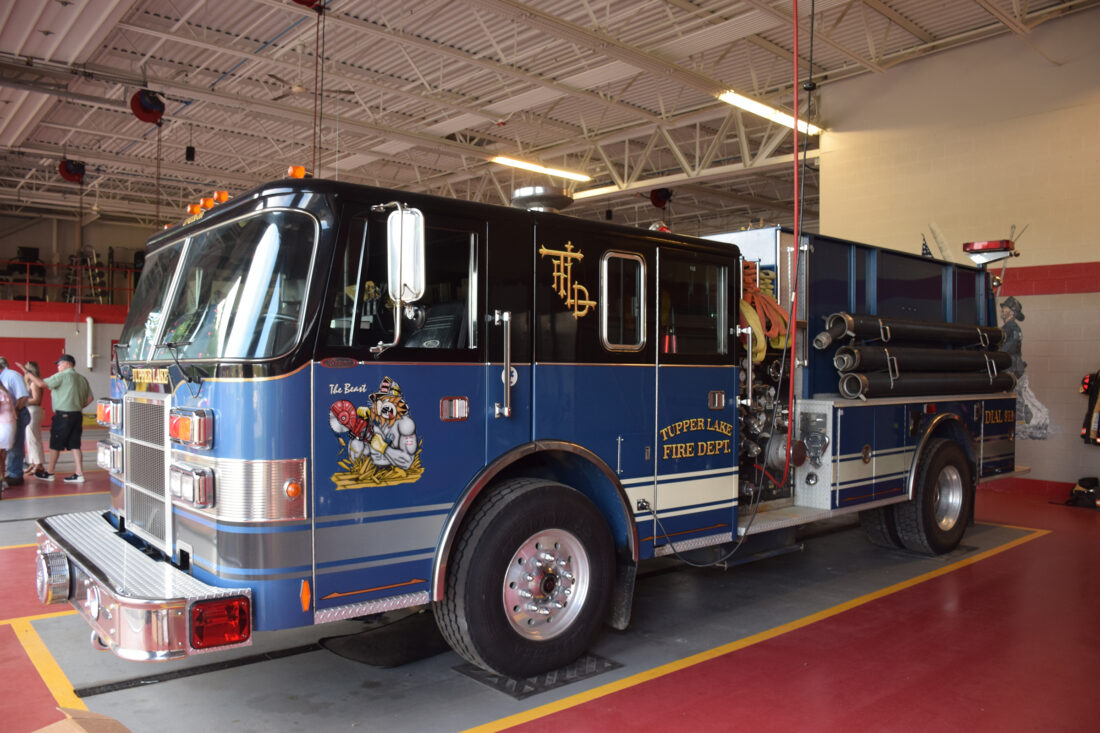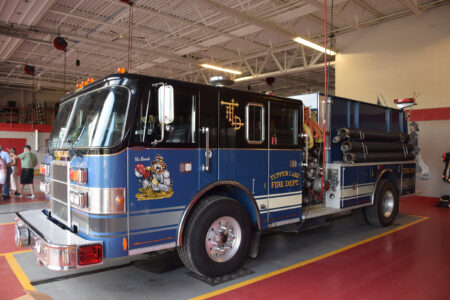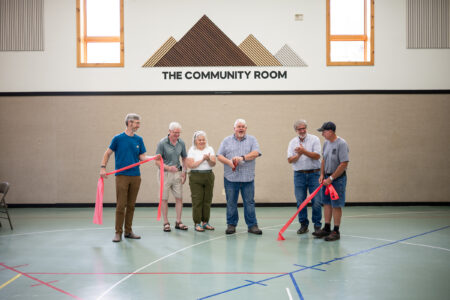New fire truck proposal may have support
No binding decisions made yet from Tupper Lake village board

Tupper Lake Volunteer Fire Department’s Unit 165 is seen at the fire station on June 30. The village is considering replacing the truck, which is about 30 years old and was purchased used from the Peru Volunteer Fire Department for $30,000 in 2015. (Enterprise photo — Chris Gaige)
TUPPER LAKE — Tupper Lake Village Board members appeared in agreement at their regular meeting on July 21 for a new fire truck purchase from E-ONE for $889,287.
No formal action toward a purchase was taken, and village Mayor Mary Fontana said the current plan is to propose a contract, and likely a bond resolution to support the purchase, at the board’s next scheduled meeting on Aug. 18 at 6 p.m. at the village offices.
Garth Brooks, the regional E-ONE sales representative who owns St. Albans, Vermont-based Desorcie Emergency Products spoke at the July meeting. Brooks’ territory covers northeastern New York, Vermont and northern New Hampshire.
His appearance was requested by the Tupper Lake Village Board following a June board meeting that grew heated at times. Multiple board members expressed displeasure, for a variety of reasons, with a truck proposal from manufacturing company Pierce.
Though Pierce was the preferred option by the Tupper Lake Volunteer Fire Department’s Truck Committee — which was tasked with researching and presenting the board with several viable purchase options — it had a higher bid of $1,069,000.
Trustees Leon LeBlanc said at the meeting it was beyond what village taxpayers could afford and Trustee Eric Shaheen took issue with how it was priced — specifically with a $200,000 deduction that was offered for payment up front. He stated that even though there was no way the village could pay up front, a delta that large struck him as the sticker price being too much.
“If there’s a $200,000 profit margin you can take right off the top if we’re paying in full for it, then you have more wiggle room than $1,069,000,” he said. That’s kind of irritating me. … I would love to see the margin on that truck. That’s just something that really clicked me when he was doing the presentation.”
A longer article on the June board meeting can be found at tinyurl.com/mvzhznyx.
It was a different scene at the July meeting, with LeBlanc and Shaheen not voicing disagreement to the E-ONE potential purchase. LeBlanc, who declined to seek reelection and whose term expires at the end of this year, said his mind wasn’t fully made up, but he didn’t have the same alarm bells as with the Pierce truck.
“I don’t have a problem with this one,” LeBlanc said. “I’m going to tell you right up front. That’s quite a savings all the way around and, like I said, I’ve been doing my research on this E-ONE, I’ve been on the websites. Hey, this is my last term. It is what it is. I could vote yes, I could vote no.”
Former village code enforcement officer and current town code enforcement officer Pete Edwards attended the July village board meeting. He said he was speaking out in his personal capacity as a citizen and taxpayer, and questioned why the village board wasn’t considering buying a used fire truck, given the strained tax base. Edwards said it was a question a lot of community members had asked him.
“May I ask, as a taxpayer, how come you have not looked into buying used trucks?” he said. “The market’s flooded with them — many under 10 years old. You could pay cash out of your truck fund for that without the taxpayers going into debt.”
Fontana said it was a fair question, and responded by saying a past village board — before her time as mayor — had promised the TLVFD that it wouldn’t buy a second-hand truck again. LeBlanc, who served on the board then, said it’s like “buying somebody else’s headache.”
Edwards said that was an opinion, and while true in some instances, has panned out well in others. He cited the truck that the village is currently seeking to replace, which was purchased used from the Peru Volunteer Fire Department for $30,000 in 2015.
Though it’s starting to deteriorate, the fact that the pumper truck, Unit 165, remains in service today with minimal repairs during its time with TLVFD is widely considered by village officials and department members to have been a worthwhile purchase.
TLVFD Chief Royce Cole responded to Edwards by stating that the used market brings a lot more uncertainty in the truck’s condition, which he said could become more costly overtime with repairs in the absence of a warranty that comes with a new truck.
“You buy used, yeah you’re going to save money, but you don’t really know what you’re going to get,” he said.
Cole added that while departments try to look out for each other — and credited Unit 165’s success in part to a strong working relationship and direct talks with the Peru Volunteer Fire Department prior to that purchase — he said it’s a different story when buying from a broker.
“It’s just like buying a regular truck,” he said. “We could go buy the E-ONE and something could go wrong, but the chances of having somebody sell us something that’s not what it is very high. I mean, departments usually try to take care of each other, but once it goes to a broker, they’re just trying to push trucks.”
–
Financial planning
–
After Brooks’ presentation and discussion, the board began to look into the finance options. Fontana noticed that she and village Treasurer Kyle Fuller will conduct a more thorough review ahead of the August board meeting, and present a range of options then.
Currently, the village has approximately $335,000 specifically earmarked for the fire truck fund. There appeared to be a bit of disagreement at the July meeting amongst board members over how much of that should be put toward the E-ONE purchase, should the board ultimately vote in favor of it.
Shaheen suggested putting the fund, in its entirety, toward the new truck, with a greater down payment, lessening the overall price. In Brooks’ presentation, he noted that any upfront payment, in any amount, is subject to a 5% simple interest discount.
“I mean if we have the ($335,000), why don’t we use the ($335,000)?” he said. “I mean, it’s a truck fund. They’re not supposed to take that money for (anything) else.”
Fontana said she understood the rationale, but thought that some money should be left in the fund as a cushion for any imminent repairs needed for TLVFD’s other apparatuses in the meantime. LeBlanc suggested taking $300,000 from the fund and leaving the remainder in for sudden repairs. Ultimately, the village board did not take any binding action on how to draw from the fund, saving that for a future meeting.
Regardless of what percentage of the truck fund is used, the village will likely have to borrow money for the purchase. In his presentation, Brooks brought up the state Emergency Services Revolving Loan Program as a possibility. The state fund allows qualifying municipalities to borrow at a fixed 2.5% interest rate, lower than the municipal bond interest rate that may be available for the village otherwise.
Fontana said she and Fuller would look into that — obviously preferring to borrow money at a lower interest rate if possible — while noting that there are a number of restrictions to the program and it might not be something the village is able to qualify for. Fuller added that the village’s last bond, which was taken out for the street sweeper that was purchased in January, carried an interest rate of around 4.2%.
–
Brooks presentation
–
Brooks offered insights into the E-ONE construction process, and discussed the various market factors that were responsible for the pumper truck’s quote to the village board. He began his presentation by noting that the TLVFD Truck Committee gave him its list of specs, but offered more latitude to him as a builder than some other customers, which helped bring the price down.
“They gave me the guidelines of what they wanted the vehicle to look like and how it was to perform if it was to be built,” he said. “They allowed me to build my truck really, which helps with the price. It keeps the price lower versus me trying to build somebody else’s truck — because we rely on a lot of our historical engineering.”
Brooks said E-ONE has built its trucks in Ocala, Florida since 1974 and that the company was currently looking at 24 to 30 month build times. It’s up from the company’s historic average of 18 months, but was something that he felt confident E-ONE would be able to hold the line on. Of that, it only takes the company about two months to build the truck, but E-ONE doesn’t begin that until all of the components are sourced and stocked at its plant — which accounts for the bulk of the time.
“The market is strange right now,” he said. “A lot of vehicles to build. Demand for vehicles is up 60%. Pricing is up 40%. Throughput is up 30% to try to match those demands. The last several years, sales have been very brisk, actually. (There is) a lot of federal money in circulation, as you probably well know, so it’s driven a lot of sales that normally wouldn’t have happened if the money wasn’t available.”
Brooks said the $889,287 deal is E-ONE’s 2024 pricing, and there haven’t yet been any increases to that this year. Fontana asked if that was coming, to which Brooks said it was a matter of time, but didn’t know when that would be. He noted that the price already factors in new Environmental Protection Agency emissions standards that are set to go into effect in 2027.
Shaheen asked how much the new standards added, and if there was any way to get ahead of it. Brooks said it amounted to an extra $85,000, approximately, but that it was too late, even if the village hypothetically signed the purchase contract that day, to procure cheaper engines ahead of the new regulations.
Fontana asked if there was any discount for buying the chassis upfront, noting that the other companies the village was considering offered that. Brooks said both yes and no — negative in the sense that there’s no discount for buying the chassis specifically up front, since E-ONE doesn’t use third-party builders for its chassis, but affirmative in that the company offers the 5% simple interest discount on any payment upfront.
That discussion led Shaheen to ask about the differences between a custom, or vocational, chassis versus a general commercial chassis for the truck. The current proposal goes with the custom chassis, and while Brooks did not know off the top of his head what the price difference was, he threw out $200,000 as a ballpark estimate.
While it’s a large price difference and is possible to build, Brooks said there are several performance drawbacks to putting a commercial chassis on a fire truck.
“When you’re buying a commercial chassis, you’re buying a truck that they use to deliver soda, deliver beer, deliver chips,” he said. “You’re very limited on any kind of customization. The commercial chassis is nowhere near as safe as a vocational chassis. (With) our cabs, you can put 120,000 pounds on the cab roof and the doors still open and the windows still go up and down. You’re going to be hard-pressed to put 30,000 pounds on a commercial roof … not that you intend to have an accident, but an accident is just what I said — you don’t expect it. You don’t plan on it.”



